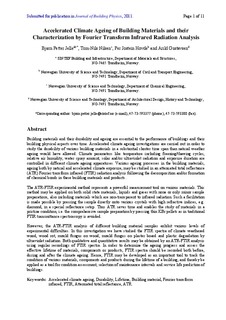Accelerated climate aging of building materials and their characterization by Fourier transform infrared radiation analysis
Journal article, Peer reviewed
Accepted version

Date
2012Metadata
Show full item recordCollections
- Publikasjoner fra CRIStin - SINTEF AS [5801]
- SINTEF Community [2247]
Abstract
Building materials and their durability and ageing are essential to the performance of buildings and their building physical aspects over time. Accelerated climate ageing investigations are carried out in order to study the durability of various building materials in a substantial shorter time span than natural weather ageing would have allowed. Climate parameters like temperature including freezing/thawing cycles, relative air humidity, water spray amount, solar and/or ultraviolet radiation and exposure duration are controlled in different climate ageing apparatuses. Various ageing processes in the building materials, ageing both by natural and accelerated climate exposure, may be studied in an attenuated total reflectance (ATR) Fourier transform infrared (FTIR) radiation an analysis following the decomposition and/or formation of chemical bonds in these building materials and products.
The ATR-FTIR experimental method represents a powerful measurement tool on various materials. This method may be applied on both solid state materials, liquids and gases with none or only minor sample preparations, also including materials which are non-transparent to infrared radiation. Such a facilitation is made possible by pressing the sample directly onto various crystals with high refractive indices, e.g. diamond, in a special reflectance setup. Thus ATR saves time and enables the study of materials in a pristine condition, i.e. the comprehensive sample prearation by pressing thin KBr pellets as in traditional FTIR transmittance spectroscopy is avoided.
However, the ATR-FTIR analysis of different build ing material samples exhibit various levels of experimental difficulties. In this investigation we have studied the FTIR spectra of climate weathered wood, wood rot, mould fungus on wood, mould fungus on plaster board and plastic degradation by ultraviolet radiation. Both qualitative and quantitative results may be obtained by an ATR-FTIR analysis using regular recordings of FTIR spectra. In order to determine the ageing progress and assess the effective lifetime of materials, components or pr oducts, FTIR spectra should be recorded both before, during and after the climate ageing. Hence, FTIR may be developed as an important tool to track the condition of various materials, com ponents and products during the lifetime of a building, and thereby be applied as a tool for condition assessment, selection of maintenance intervals and service life prediction of buildings.